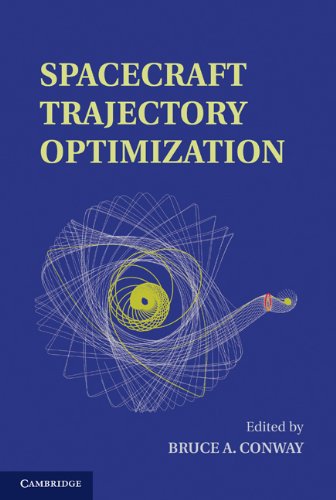| Book Name: | Spacecraft Trajectory Optimization |
| Category: | Aerospace Engineering |
| Free Download: | Available |
Spacecraft Trajectory Optimization

Book Description:
This is a long-overdue volume dedicated to space trajectory optimization. Interest in the subject has grown as space missions of increasing sophistication, complexity, and scientific return – hardly imaginable in the 1960s – have been designed and flown. Although the basic tools of optimization theory remain an accepted canon, there has been a revolution in the manner in which they are applied and in the development of numerical optimization. This volume purposely includes various analytical and numerical approaches to trajectory optimization. The choice of authors has been guided by the editor’s intention to assemble the most expert and active researchers in the various specialties presented. The authors were given considerable freedom to choose their subjects. Although this may yield a somewhat eclectic volume, it also yields chapters written with palpable enthusiasm and relevant to contemporary problems.
Table of contents:
Half-title……Page 3
Series title……Page 5
Title……Page 7
Copyright……Page 8
Contents……Page 9
Preface……Page 13
1.1 Introduction……Page 15
1.2 Solution Methods……Page 17
1.2.1 Analytical Solutions……Page 18
1.2.2 Numerical Solutions via Discretization……Page 21
1.2.3 Evolutionary Algorithms……Page 23
1.3 The Situation Today with Regard to Solving Optimal Control Problems……Page 26
2.1 Introduction……Page 30
2.2.1 Optimal Constant-Specific-Impulse Trajectory……Page 31
2.2.2 Optimal Impulsive Trajectory……Page 35
2.2.3 Optimal Variable-Specific-Impulse Trajectory……Page 36
2.3 Solution to the Primer Vector Equation……Page 37
2.4 Application of Primer Vector Theory to an Optimal Impulsive Trajectory……Page 38
2.4.1 Criterion for a Terminal Coast……Page 40
2.4.2 Criterion for Addition of a Midcourse Impulse……Page 44
2.4.3 Iteration on a Midcourse Impulse Position and Time……Page 47
3.1 Introduction……Page 51
3.2.1 A Basic Collocation Method (Using Hermite Polynomials)……Page 54
3.2.2 Pseudospectral Methods……Page 59
3.2.3 A Direct Method Not Using Collocation: R-K Parallel-Shooting……Page 61
3.2.4 Comparison of Direct Transcription Methods……Page 63
3.3.1 Motivation for Choice of Coordinate System……Page 66
3.3.2 Coordinate Transformations……Page 70
3.3.3 Interplanetary Trajectories……Page 73
3.4.1 Impulsive Thrust Case……Page 74
3.4.3 Power-Limited Case……Page 75
3.5 Generating an Initial Guess……Page 76
3.5.1 Using a Known Optimal Control Strategy……Page 77
3.5.3 Using Evolutionary Methods to Generate an Initial Guess……Page 78
3.6.1 Equation Scaling……Page 79
3.6.2 Grid Refinement……Page 81
3.6.3 Other Grid Refinement Strategies……Page 84
3.7.1 Optimality of Assumed Control Switching Structures and the DiscreteSwitch Function……Page 85
3.7.2 Example: Two and Three Thrust-Arc Rendezvous……Page 87
3.7.3 Verifying Optimality by Integration of the Euler-Lagrange Equations……Page 88
4.1 Introduction……Page 93
4.2 Trajectory Model……Page 94
4.4 Finite Burn Control Models……Page 99
4.4.1 Thrust Vector Parameter Model……Page 100
4.4.2 Thrust Vector Optimal Control Model……Page 101
4.5 Solution Methods……Page 104
4.5.3 Nonlinear Programming Problem: mineq0,0meq
Spacecraft Trajectory Optimization (Cambridge Aerospace Series)
Author(s): Bruce Conway
Year: 2010
ISBN: 9780521518505









![[PDF] Draw Buildings and Cities in 15 Minutes Draw Buildings and Cities in 15 Minutes pdf](https://www.freepdfbook.com/wp-content/uploads/2021/06/Draw-Buildings-and-Cities-in-15-Minutes-218x150.jpg)








![[PDF] Digital Image Processing An Algorithmic Introduction Using Java Digital Image Processing An Algorithmic Introduction Using Java](https://www.freepdfbook.com/wp-content/uploads/2022/06/Digital-Image-Processing-An-Algorithmic-Introduction-Using-Java.jpg)




![[PDF] 43 Years JEE ADVANCED + JEE MAIN Chapterwise & Topicwise Solved Papers 43 Years JEE ADVANCED (1978-2020) + JEE MAIN Chapterwise & Topicwise Solved Papers Physics PDF](https://www.freepdfbook.com/wp-content/uploads/2022/03/43-Years-JEE-ADVANCED-1978-2020.jpg)

![[PDF] Problems in Physical Chemistry for JEE (Main & Advanced) Problems in Physical Chemistry for JEE (Main & Advanced) Free PDF Book Download](https://www.freepdfbook.com/wp-content/uploads/2022/03/Problems-in-Physical-Chemistry-for-JEE-Main-Advanced.jpg)
![[PDF] Engineering Physics (McGraw Hill)](https://www.freepdfbook.com/wp-content/uploads/2021/05/bafc8c2685bb6823a9c56134f7fba5df.jpeg)

![[PDF] Engineering Chemistry By Shashi Chawla](https://www.freepdfbook.com/wp-content/uploads/2022/05/Theory-And-Practicals-of-Engineering-Chemistry-By-Shashi-Chawla-free-pdf-book.jpeg)
![[PDF] Chemistry: An Introduction to Organic, Inorganic & Physical Chemistry Chemistry: An Introduction to Organic, Inorganic & Physical Chemistry](https://www.freepdfbook.com/wp-content/uploads/2022/04/Chemistry-An-Introduction-to-Organic-Inorganic-Physical-Chemistry.jpg)
![[PDF] Essentials of Physical Chemistry Essentials of Physical Chemistry Free PDF Book by Bahl](https://www.freepdfbook.com/wp-content/uploads/2022/04/Essentials-of-Physical-Chemistry-bahl.jpg)
![[PDF] Biological control of plant-parasitic nematodes: soil ecosystem management in sustainable agriculture Biological control of plant-parasitic nematodes: soil ecosystem management in sustainable agriculture](https://www.freepdfbook.com/wp-content/uploads/2022/05/Biological-control-of-plant-parasitic-nematodes-soil-ecosystem-management-in-sustainable-agriculture.jpg)
![[PDF] Human Anatomy: Color Atlas and Textbook Human Anatomy: Color Atlas and Textbook Free PDF Book](https://www.freepdfbook.com/wp-content/uploads/2022/05/Human-Anatomy-Color-Atlas-and-Textbook.jpg)
![[PDF] Concepts of Biology Book [Free Download]](https://www.freepdfbook.com/wp-content/uploads/2022/05/Concepts-of-Biology.jpg)
![[PDF] Essentials of Biology [Free Download] Essentials of Biology Free PDF BOok Download](https://www.freepdfbook.com/wp-content/uploads/2022/05/Essentials-of-Biology-Free-PDF-Book-Downlaod.jpg)
![[PDF] Human Biology Book [Free Download]](https://www.freepdfbook.com/wp-content/uploads/2022/05/PDF-Human-Biology-Book-Free-Download.jpg)


